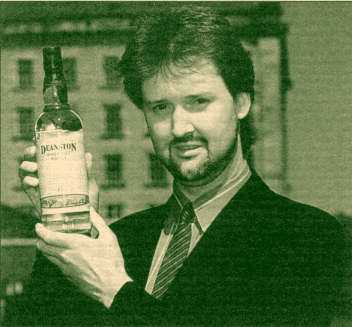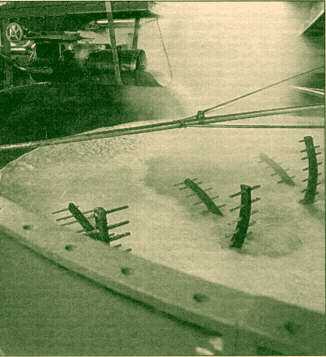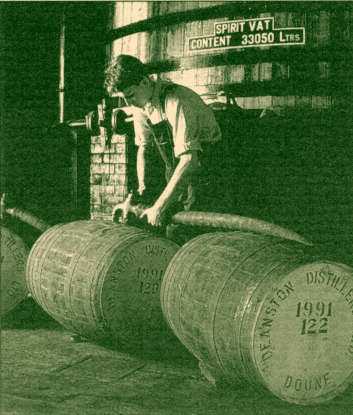 Somewhere near the ancient Perthshirevillage of Doune, you take a B-road. Then an even narrowerB-road. Then on the edge of the chattering waters of the RiverTeith, you discover an 18th century cotton mill.
Somewhere near the ancient Perthshirevillage of Doune, you take a B-road. Then an even narrowerB-road. Then on the edge of the chattering waters of the RiverTeith, you discover an 18th century cotton mill.Anthony Troon explores the Highland maltdistillery that hides inside a cotton mill
 Somewhere near the ancient Perthshirevillage of Doune, you take a B-road. Then an even narrowerB-road. Then on the edge of the chattering waters of the RiverTeith, you discover an 18th century cotton mill.
Somewhere near the ancient Perthshirevillage of Doune, you take a B-road. Then an even narrowerB-road. Then on the edge of the chattering waters of the RiverTeith, you discover an 18th century cotton mill.
It is undeniably a cotton mill. The size and the statelyproportions proclaim it as such, although you'd be hard-put tofind a cotton mill still operating in Scotland. Yet all thesigns, from the buzz of industry to the plume of steam, tells youthat this place is still in business. The secret lies inside.
This is a cotton mill that became a malt whisky distillery,and did so with great alacrity, as if it was discovering itshigher role in the world. All the facilities were there:plentiful water for power, which was also soft water forwhisky-making, a sylvan setting, an optimistic climate in thedistilling industry when the transformation came about in themid-Sixties.
The malt is called Deanston, and Society members (who havesipped it enthusiastically as No. 79) will not be unfamiliar withthe name. But, with the conventional picture of a malt whiskydistillery in their minds, they could hardly imagine itsbirthplace.
So first, let us go back to 1785. That is when the cotton millcame into being, to be described in The First Statistical Accountof Scotland as having 'the most perfect machinery in thekingdom'. The owners were four brothers, one of whom wasassociated with Sir Richard Arkwright, English inventor of thewater-powered spinning frame.
But here's an interesting touch. 'The English had annoyed SirRichard so much by invading his invention he resolved to instructyoung Scotsmen in the art, in preference to his own countrymen.'Oh dear.
The mill passed through several hands until it ceasedproduction in 1965. So then, an enormous complex with vaststorage space came on the market and attracted the interest ofBrodie Hepburn Ltd, at that time the company operating the nearbyTullibardine Distillery. It seemed ideal for warehousing. Butwhen they inspected it (and remember, these were highlyoptimistic times) their minds turned inevitably to a newdistillery.
The waters of the Teith were analysed. Flowing from feederstreams high in the Trossachs, filtered through granite andrunning over peat beds, this stuff was far too good for thecotton business. Not only that, but the river gave the mill itsown power supply through two turbines, one of which has beenworking faithfully since the mid-Twenties. Incredibly, thisset-up produced so much juice that it could sell the surplus tothe national grid.
The water-power is conducted to the turbines from a 1.5 mileman-made lade, later returning to the river through a 300-metretunnel of splendid arched masonry. The water arrives at two hugecast-iron flumes which once fed four gigantic overshot wheels,each rated at 80 horse-power: a gem of the Industrial Revolutionnow adapted to a later century.
In partnership with the mill-owners, Brodie Hepburn plunged soenthusiastically into the conversion work that this superb cottonmill started producing its first malt whisky only 10 months afterthe deal was agreed. The first drams were bottled as a five orsix-year-old single called 'Old Bannockburn' and put into a blendnamed 'Teith Mill'
 The strategy of the new company,Deanston Distillers Ltd, was to buy an established blendbrand-name and use their malt as the basis. This didn't happen,and in 1972 both Deanston and Tullibardine distilleries becamepart of Invergordon Distillers. In 1982, Deanston was mothballed.
The strategy of the new company,Deanston Distillers Ltd, was to buy an established blendbrand-name and use their malt as the basis. This didn't happen,and in 1972 both Deanston and Tullibardine distilleries becamepart of Invergordon Distillers. In 1982, Deanston was mothballed.
Now we come to the story of Deanston as it is today. In 1990the distillery was bought by Burn Stewart, the Glasgow company ofblenders and bottlers ambitious to expand into distilling. (Theseambitions were underlined in July this year when the companybought the faltering Ledaig Distillery on the Isle of Mull.)
Deanston's new manager Ian Macmillan, was one of the first toinspect the new acquisition beside the Teith. The mothballeddistillery, hidden inside the cotton mill, was complete allright: but there were archaic parts of the operation that had tobe improved.
One was the system for filling the eight 60,000 litrewashbacks. The worts were pumped in from above through a singledismountable pipe of copper and plastic, rather like a gardenhose. So a first job was to install permanent stainless-steelpipes and valves, to fill the washbacks in a more efficient anddignified fashion, incorporating an in-house cleaning system.
 But there was much about thequarter-century-old fittings that gave pleasure. From the four25-tonne malt bins, the barley is conveyed to an unusuallyelegant wooden-panelled room where the 1966 Porteous mill grindsaway in some state. The elevators that convey the grist, and theequipment for extracting dust and pebbles, are neatly encased inwood.
But there was much about thequarter-century-old fittings that gave pleasure. From the four25-tonne malt bins, the barley is conveyed to an unusuallyelegant wooden-panelled room where the 1966 Porteous mill grindsaway in some state. The elevators that convey the grist, and theequipment for extracting dust and pebbles, are neatly encased inwood.
The enormous cast-iron mash tun, open-topped and with a falsebottom of brass plates, is a high-quality piece of engineeringmade by an Alloa foundry that no longer exists. Newlyrefurbished, it is equipped with a mechanical mixing-rake,circling on a track of fixed cogs. Ian MacMillan finds its gentlemixing action superior to the blades of the more modern Lautertun: it produces a dark, clear, unclouded wort, free of solids.
Deanston's two pairs of stills (by Archbd McMillan and Co,Prestonpans) are large and bulbous but also high. Unusually, thelyne arms from the swan neck to the condensers are set at aslight upward angle, aiding the reflux action which give a purerspirit.
 One of the maturing warehouses isbeautiful beyond description, a former weaving shed from 1785 ofarched stone roofing that would bring a hush to a chateau inBurgundy. Here and in more modern racks, the distillery can store45,000 casks, and the oldest Deanston they hold is the 1967.
One of the maturing warehouses isbeautiful beyond description, a former weaving shed from 1785 ofarched stone roofing that would bring a hush to a chateau inBurgundy. Here and in more modern racks, the distillery can store45,000 casks, and the oldest Deanston they hold is the 1967.
But of course, the whisky stocks they took over were ofsomebody else's distillation. It will be the next millenniumbefore we taste the Deanston presided over by Ian MacMillan. Whatwill it be like? 'Even better,' he said (and he has been checkingon its progress).
His aim and that of production director Billy Walker, aftermonths of initial experimentation, is to use only the residualpeaty phenols of the Teith's soft waters and to mash withunpeated malt from Angus, East Lothian and Moray. 'The resultwill be a lightly-peated sweet whisky with the flavour of themalt dominant.'
An eighth of Deanston's new production, matured in whisky andbourbon refill casks and possibly with no sherry-cask whiskyinvolved, will be bottled as the single, maybe from the year2000. So...patience, friends.
If you have comments about thissite, please contact the